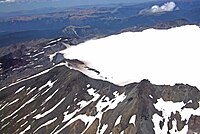
Photo from wikipedia
Paleosecular variation determinations and studies of the geometry of the Earth’s main magnetic field provide important information about the field evolution, and to constrain numerical geodynamo models. Paleomagnetic directional data… Click to show full abstract
Paleosecular variation determinations and studies of the geometry of the Earth’s main magnetic field provide important information about the field evolution, and to constrain numerical geodynamo models. Paleomagnetic directional data from lava flows over the last few million years is of particular interest because the regional and global tectonic effects are minimal. However, the distribution of this type of paleomagnetic data is uneven where the Southern Hemisphere is the destitute side. Therefore, the better knowledge of the geomagnetic field behavior depends on the increased availability of high-quality data, especially in the Southern Hemisphere. A paleosecular variation (PSV) and the time-averaged field (TAF) study was then performed in 0-5 Ma lava flows from the Caviahue-Copahue Volcanic Complex located in Northern Patagonia, Argentina (37○0’S, 71○10’W). The magnetic mineralogy of lava flows was investigated through thermomagnetic susceptibility curves, isothermal remanent magnetization (IRM) acquisition curves, hysteresis loops, and first-order reversal curves (FORCs). Samples are essentially comprised of titanomagnetite with different Ti contents and magnetic domain structures typical of vortex state particles. A total of 50 volcanic sites were sampled, which provided 42 reliable paleomagnetic site-mean directions after alternating field and thermal demagnetization. From these 42 sites, 36 are of normal and 6 are of reversed polarity. The mean direction from normal (reversed) sites is D = 356.2○, I = −50.1○, α95 = 4.0○, N = 36 (D = 176.5○, I = 59.5○, α95 = 14.1○, N = 6). Using only site-level data with the precision parameter k ≥ 100, we obtain 26 paleomagnetic sites for PSV and TAF investigations in the study region. The filtered dataset has a mean direction (D = 354.4○, I = −53.2○, α95 = 5.1○) close to the expected direction for a geocentric axial dipole (GAD) field (IGAD = −57.3○). The paleopole (Plat = 84.4○, Plon = 229.1○, A95 = 5.7○) coincides with the Earth’s spin axis within the 95% confidence interval. Virtual geomagnetic pole scatter ($S_{B} = {15.8^{18.9}_{11.8}}^{\circ }$) and the inclination anomaly ($\Delta I = 4.1_{-1.0}^{{9.2}^{\circ }}$) are both consistent at the 95% confidence level with recent PSV and TAF models, respectively. Our results support the presence of small non-dipole field contributions ($< 3\%$) superimposed on the GAD term, as reported by South American studies at mid southern latitudes.
Journal Title: Geophysical Journal International
Year Published: 2023
Link to full text (if available)
Share on Social Media: Sign Up to like & get
recommendations!